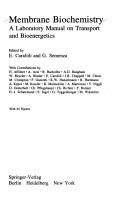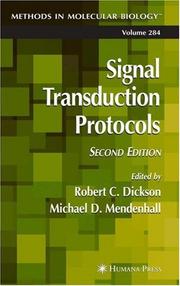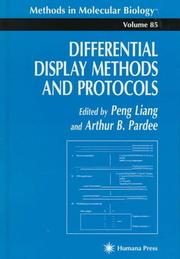| Listing 1 - 10 of 11 | << page >> |
Sort by
|

ISBN: 0443008760 9780443008764 Year: 1972 Publisher: Edinburgh Churchill Livingstone
Abstract | Keywords | Export | Availability | Bookmark
 Loading...
Loading...Choose an application
- Reference Manager
- EndNote
- RefWorks (Direct export to RefWorks)
Book
ISBN: 1607618117 1607618109 9781607618102 Year: 2010 Publisher: Totowa, NJ : Humana Press : Imprint: Humana,
Abstract | Keywords | Export | Availability | Bookmark
 Loading...
Loading...Choose an application
- Reference Manager
- EndNote
- RefWorks (Direct export to RefWorks)
In recent years, the critical role of microRNAs has been revealed within the biology of cells that constitute the immune system. In MicroRNAs and the Immune System: Methods and Protocols, expert researchers explore the latest techniques for studying miRNA expression, including the most up-to-date data on splinted ligation and qRT-PCR assays, as well as high-throughput profiling through cloning, deep sequencing, and microarrays. Chapters outline methods to study miRNA functions in various cell types from a single cell type level to entire model organisms, and present studies of miRNAs in the context of viruses and the immune response. Tools are also provided to help navigate bioinformatics databases on miRNAs and their targets. Composed in the highly successful Methods in Molecular Biology™ series format, each chapter contains a brief introduction, step-by-step methods, a list of necessary materials, and a Notes section which shares tips on troubleshooting and avoiding known pitfalls. Contemporary and innovative, MicroRNAs and the Immune System: Methods and Protocols is an essential handbook for immunologists, biochemists, and molecular biologists.
Immunology. --- Immunobiology --- Life sciences --- Serology --- Small interfering RNA --- Immune system --- Immune system - Physiology - Laboratory manuals

ISBN: 0896038734 9786610359936 1280359935 1592598129 9780896038738 Year: 2004 Volume: 282 Publisher: Totowa, NJ : Humana Press : Imprint: Humana,
Abstract | Keywords | Export | Availability | Bookmark
 Loading...
Loading...Choose an application
- Reference Manager
- EndNote
- RefWorks (Direct export to RefWorks)
The ability to detect and quantify apoptosis, to understand its biochemistry, and to identify its regulatory genes and proteins is crucial to biomedical research in the 21st century. In Apoptosis Methods and Protocols, highly experienced researchers in the field of apoptosis describe in step-by-step detail the techniques they have perfected to investigate the critical steps involved in the apoptotic process. These readily reproducible methods range from flow cytometry and immunohistochemical procedures to kinase activity assays, yeast two-hybrid screening, and the cloning of novel genes by differential expression. The protocols follow the successful Methods in Molecular Biology™ series format, each one offering step-by-step laboratory instructions, an introduction outlining the principle behind the technique, lists of equipment and reagents, and tips on troubleshooting and avoiding known pitfalls. State-of-the-art and highly practical, Apoptosis Methods and Protocols constitutes a key technical reference to the significant methodologies used in the field, as well as offering novice and experienced researchers alike powerful tools to illuminate the phenomenon of programmed cell death.
Apoptosis --- Molecular biology --- DNA Damage --- physiology --- Apoptosis -- Laboratory manuals. --- Molecular biology -- Laboratory manuals. --- Biological Science Disciplines --- Genetic Processes --- Cell Death --- Publication Formats --- Publication Characteristics --- Genetic Phenomena --- Cell Physiological Processes --- Natural Science Disciplines --- Disciplines and Occupations --- Phenomena and Processes --- Cell Physiological Phenomena --- Laboratory Manuals --- Physiology --- Biology --- Health & Biological Sciences --- Cytology --- Cell death --- Cytology. --- Cell Biology. --- Cell biology --- Cellular biology --- Cells --- Cytologists --- Apoptosis - Laboratory manuals. --- Molecular biology - Laboratory manuals. --- DNA Damage - physiology - Laboratory Manuals. --- Apoptosis - physiology - laboratory manuals

ISBN: 0387098445 3540098445 3642675301 Year: 1979 Publisher: New York
Abstract | Keywords | Export | Availability | Bookmark
 Loading...
Loading...Choose an application
- Reference Manager
- EndNote
- RefWorks (Direct export to RefWorks)
Biological techniques --- Biomembranes --- Bioenergetics --- Biological transport --- CELL MEMBRANE, physiology, laboratory manuals. --- ENERGY METABOLISM, laboratory manuals. --- Membranes (Biology) --- Laboratory manuals. --- Cell membrane, physiology, laboratory manuals. --- Energy metabolism, laboratory manuals. --- Membranes (biology) --- Biological Transport. --- Cell Membrane --- Energy Metabolism. --- 577.35 --- 577.23 --- 577.23 Energy bases of life. Molecular bioenergetics --- Energy bases of life. Molecular bioenergetics --- 577.35 Biophysics of living systems --- Biophysics of living systems --- Energy Expenditure --- Bioenergetic --- Energy Expenditures --- Energy Metabolisms --- Expenditure, Energy --- Expenditures, Energy --- Metabolism, Energy --- Metabolisms, Energy --- Biologic Transport --- Transport, Biological --- Transport, Biologic --- Transport Vesicles --- Membrane Transport Proteins --- physiology. --- Biological Transport --- Energy Metabolism --- physiology

ISBN: 030631066X 1461339723 1461339707 9780306310669 Year: 1978 Publisher: New York Plenum Press
Abstract | Keywords | Export | Availability | Bookmark
 Loading...
Loading...Choose an application
- Reference Manager
- EndNote
- RefWorks (Direct export to RefWorks)
Biomathematics. Biometry. Biostatistics --- Animal physiology. Animal biophysics --- Human physiology --- Physiology --- System analysis --- Systems analysis --- Data processing --- Mathematical models --- -Physiology --- -System analysis --- Network theory --- System theory --- Mathematical optimization --- Animal physiology --- Animals --- Biology --- Anatomy --- Network analysis --- Network science --- System analysis. --- Physiology - Data processing --- Physiology - Mathematical models --- Physiology - laboratory manuals --- Systems analysis - laboratory manuals
Book
ISBN: 0231036426 9780231036429 Year: 1973 Publisher: New York (N.Y.) : Columbia university press,
Abstract | Keywords | Export | Availability | Bookmark
 Loading...
Loading...Choose an application
- Reference Manager
- EndNote
- RefWorks (Direct export to RefWorks)
Biochemistry --- Plants --- Botanical chemistry --- Plant physiology --- Physiologie végétale --- laboratory manuals --- physiology --- Laboratory manuals --- Manuels de laboratoire --- Basic Sciences. Molecular Biology --- Laboratory manuals. --- Plant Molecular Biology --- Plant Molecular Biology. --- Physiologie végétale --- laboratory manuals. --- Botanical chemistry - Laboratory manuals --- Plant physiology - Laboratory manuals
Book
ISBN: 0582441277 9780582441279 Year: 1976 Publisher: London Longman
Abstract | Keywords | Export | Availability | Bookmark
 Loading...
Loading...Choose an application
- Reference Manager
- EndNote
- RefWorks (Direct export to RefWorks)
Plant physiology --- Laboratory manuals --- -581.1 --- 58.08 --- 577.1 --- Botany --- Plants --- Physiology --- Botanic techniques. Experimental methods. Equipment --- Chemical bases of life. Biochemistry and bio-organic chemistry generally --- 577.1 Chemical bases of life. Biochemistry and bio-organic chemistry generally --- 58.08 Botanic techniques. Experimental methods. Equipment --- 581.1 Plant physiology --- 581.1 --- Plant physiology - Laboratory manuals
Book
ISBN: 0123918626 0123918731 Year: 2013 Publisher: San Diego, Calif. : Elsevier,
Abstract | Keywords | Export | Availability | Bookmark
 Loading...
Loading...Choose an application
- Reference Manager
- EndNote
- RefWorks (Direct export to RefWorks)
This new volume of Methods in Enzymology continues the legacy of this premier serial by containing quality chapters authored by leaders in the field. This volume covers G protein coupled receptors and includes chapters on such topics as G protein-coupled receptor trafficking motifs, structure-based virtual screening, and automation-friendly high throughput assays for identification of pharmacoperone drugs.Continues the legacy of this premier serial with quality chapters authored by leaders in the field Covers G protein coupled receptorsContains chapters
Cell receptors -- Research -- Methodology. --- Cellular signal transduction -- Research -- Methodology. --- G proteins -- Receptors. --- Signal transduction -- Physiology -- Laboratory manuals. --- Metabolism --- Biological Transport --- Receptors, Cell Surface --- Biochemical Processes --- Membrane Proteins --- Biochemical Phenomena --- Chemical Processes --- Metabolic Phenomena --- Phenomena and Processes --- Chemical Phenomena --- Proteins --- Amino Acids, Peptides, and Proteins --- Chemicals and Drugs --- Receptors, G-Protein-Coupled --- Protein Transport --- Protein Binding --- Human Anatomy & Physiology --- Health & Biological Sciences --- Animal Biochemistry --- G proteins --- Receptors. --- GTP-binding proteins --- GTP regulatory proteins --- Guanine nucleotide-binding proteins --- Guanine nucleotide regulatory proteins --- Membrane proteins --- Enzymology.

ISBN: 1588292452 1592598161 9786610359899 1280359897 9781592598168 9781588292452 Year: 2004 Volume: 284 Publisher: Totowa, NJ : Humana Press : Imprint: Humana,
Abstract | Keywords | Export | Availability | Bookmark
 Loading...
Loading...Choose an application
- Reference Manager
- EndNote
- RefWorks (Direct export to RefWorks)
Carrying on the high standards of the much-acclaimed first edition, highly experienced investigators have extensively updated Signal Transduction Protocols with many of the new approaches that have been transforming the field. Included in this new edition are readily reproducible immunoassays, fluorescence-based assays, high-throughput methods, protein modification assays, lipid second messenger assays, and chromatin immunoprecipitation techniques. Wherever possible, protocols for the assay of general classes of signal transduction components have been identified so they can be adapted to the assay of any member of that class. The protocols follow the successful Methods in Molecular Biology™ series format, each one offering step-by-step laboratory instructions, an introduction outlining the principle behind the technique, lists of the necessary equipment and reagents, and tips on troubleshooting and avoiding known pitfalls. State-of-the-art and eminently practical, Signal Transduction Protocols, 2nd ed. offers novice and experienced researchers alike an indispensable set of standardized, but readily adaptable, approaches for the assay of key signaling molecules-an invaluable tool for all laboratories newly entering the field, expanding the breadth of previous investigations, or seeking to improve an existing approach.
Cellular signal transduction --- G proteins --- Cell receptors --- GTP-Binding Proteins --- Signal Transduction --- analysis --- physiology --- Cell membrane receptors --- Cell surface receptors --- Receptors, Cell --- Binding sites (Biochemistry) --- Cell membranes --- Proteins --- GTP-binding proteins --- GTP regulatory proteins --- Guanine nucleotide-binding proteins --- Guanine nucleotide regulatory proteins --- Membrane proteins --- Cellular information transduction --- Information transduction, Cellular --- Signal transduction, Cellular --- Bioenergetics --- Cellular control mechanisms --- Information theory in biology --- Cytology. --- Cell Biology. --- Cell biology --- Cellular biology --- Biology --- Cells --- Cytologists --- Cellular signal transduction - Laboratory manuals --- G proteins - Laboratory manuals --- Cell receptors - Laboratory manuals --- GTP-Binding Proteins - analysis - laboratory manuals --- Signal Transduction - physiology - Laboratory Manuals

ISBN: 0896034895 0896034054 1592595693 9780896034051 Year: 1997 Volume: 85 Publisher: Totowa, NJ : Humana Press : Imprint: Humana,
Abstract | Keywords | Export | Availability | Bookmark
 Loading...
Loading...Choose an application
- Reference Manager
- EndNote
- RefWorks (Direct export to RefWorks)
Drs. Peng Liang and Arthur B. Pardee have in Differential Display Methods and Protocols assembled for the first time a comprehensive review of the state of the art of their powerful new methodology and its practical applications. The book's pioneering contributors describe all the major elements of this novel technology, including both RAP-PCR and DD using fluorescence detection, as well as their powerful strategy for identifying and cloning family-specific genes. Also provided are numerous examples-along with detailed experimental procedures-in which differentially expressed genes have been successfully identified in diverse biological systems ranging from plants to songbirds to humans. Comprehensive and on the cutting-edge, Differential Display Methods and Protocols provides readers with precise new tools for studying how gene expression is exactly regulated throughout the development of a living organism, and how the failure of this intricate control mechanism leads to pathological complications. This novel and productive methodology, fully detailed here, is already playing a major role in the development of selective antagonists and inhibitors for treating cancer, cardiovascular disease, CNS disorders, and inflammation and tissue repair. Now scientists everywhere can successfully apply this powerful set of techniques using the step-by-step procedures of its innovators.
DNA fingerprinting. --- Gene expression --- Messenger RNA --- Polymerase chain reaction. --- Research --- Methodology. --- Laboratory manuals. --- 57.088.5 --- 577.212.3 --- 577.212.3 Nucleic acid base and sequence compositon. Experimental deciphering of genetic code. --- Nucleic acid base and sequence compositon. Experimental deciphering of genetic code. --- Methods and techniques for studying structures and properties of biological molecules --- Life sciences. --- Cell biology. --- Life Sciences. --- Cell Biology. --- Cell biology --- Cellular biology --- Biology --- Cells --- Cytologists --- Biosciences --- Sciences, Life --- Science --- Polymerase chain reaction --- DNA fingerprinting --- Cloning, Molecular --- Gene Expression --- Molecular Biology --- Polymerase Chain Reaction --- Gene Expression Regulation. --- Methodology --- methods --- physiology --- methods. --- Cytology. --- Messenger RNA - Laboratory manuals --- Gene expression - Research - Methodology --- Cloning, Molecular - methods - laboratory manuals --- Gene Expression - physiology - laboratory manuals --- Molecular Biology - methods - laboratory manuals --- Polymerase Chain Reaction - methods - Laboratory Manuals --- Molecular Biology - methods. --- Cloning, Molecular - methods. --- Polymerase Chain Reaction - methods.
| Listing 1 - 10 of 11 | << page >> |
Sort by
|

 Search
Search Feedback
Feedback About UniCat
About UniCat  Help
Help News
News